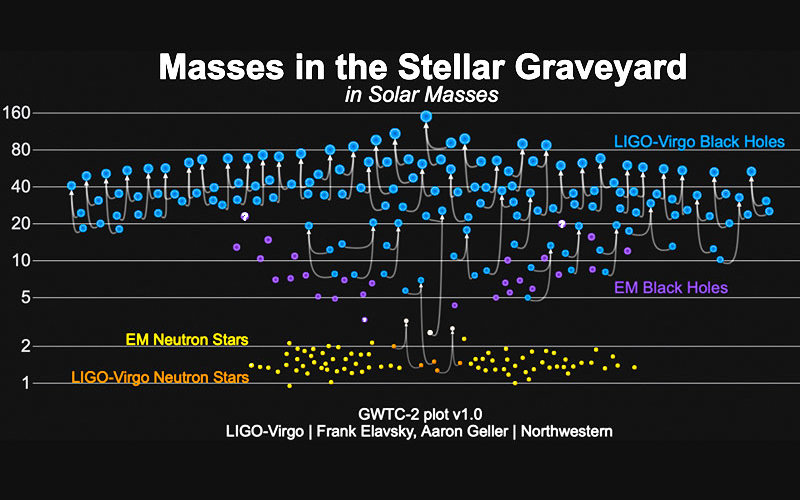
Physics major Teresita Ramirez Aguilar listens to the movie soundtrack from “The Theory of Everything” about famed astrophysicist Stephen Hawking when working on her own research of colliding black holes and neutron stars that produce gravitational waves.
It is only fitting because gravitational waves, the result of the cosmic smashups of black holes and neutron stars, are becoming relatively common in the universe. Ramirez Aguilar, a senior, also aspires to a career as an astrophysicist.
Ramirez Aguilar and a team of students and faculty members in Cal State Fullerton’s Nicholas and Lee Begovich Center for Gravitational-Wave Physics and Astronomy (GWPAC) contributed to the latest detection and analysis of more gravitational waves that the LIGO (Laser Interferometer Gravitational-wave Observatory) and European Virgo detectors have observed over the past six months.
Their research appears in the Oct. 28 announcement by LIGO and Virgo of a new catalog that contains 50 gravitational-wave detections over the past five years, including 39 new signals from black hole or neutron star collisions discovered between April 1 and Oct. 1, 2019. The new signals more than triple the number of confirmed detections produced, compared to the previous two observing periods by the network of global scientists, which includes GWPAC researchers.
More than 100 years ago, Einstein’s theory of relativity predicted that gravitational waves — ripples in the fabric of space-time that travel at the speed of light — exist. The LIGO Scientific Collaboration, which includes CSUF faculty, student and alumni researchers, successfully made its first gravitational-wave discovery in 2015, produced by the merger of two binary black holes. Since then, the LIGO and Virgo collaborations have cataloged gravitational signals from various sources, such as binary neutron star systems, binary black hole systems, and even potential black hole-neutron star mergers.
After several months of thorough analysis, this week LIGO and Virgo released the updated catalog of gravitational wave detections, which includes some of the most interesting systems the scientists have observed so far, and enables qualitatively new studies of astrophysical populations and fundamental physics, said Joshua Smith, professor of physics and Dan Black Director of Gravitational Wave Physics and Astronomy.
The boost in the number of detections was made possible by significant improvements to the instruments at LIGO’s two U.S. observatories in Washington and Louisiana, and Virgo’s detector in Italy.
“These new gravitational signals are allowing scientists to better understand the populations of black holes and neutron stars,” Smith said. “The signals in the updated catalog test Einstein’s theory of general relativity in more and better ways than before.”
The supercomputer animation that Ramirez Aguilar helped create with her faculty adviser Geoffrey Lovelace, associate professor of physics, for the new catalog is a visualization of 38 confirmed merging black holes that LIGO and Virgo have observed since 2015. It shows the horizons of binary black hole systems as they orbit each other, spiral together, merge, and ring down to a final, bigger black hole. The horizon of a black hole is the region where once something crosses the horizon, it can no longer escape, Ramirez Aguilar explained.
Ramirez Aguilar developed the animation of an orrery — a virtual planetarium that shows astronomical bodies and their positions and motions with respect to each other — using computer programming and visualization software. She and Lovelace were inspired by the Kepler Orrery IV, an animation showing the orbits of exoplanets discovered by NASA’s Kepler Mission.
This animation of the LIGO/Virgo Binary-Black-Hole Orrery shows merging black holes that LIGO and Virgo have observed so far. The video shows numerical-relativity calculations of the black holes’ horizons and the emitted gravitational waves during the final few orbits of the black holes as they spiral inwards, merge and ring down. Each calculation is consistent with one of the observations in the LIGO-Virgo catalog. This movie is inspired by the Kepler Orrery. Credits: Teresita Ramirez Aguilar and Geoffrey Lovelace, Cal State Fullerton/SXS Collaboration/LIGO-Virgo Collaboration
“Our animation shows calculations of the black holes’ horizons for the strongest gravitational-wave signals from binary black holes that LIGO observed in the first half of 2020,” she said.
Ramirez Aguilar, a first-generation college student, is on track to graduate next year and is now applying to graduate schools to pursue a doctorate. She is a student in the university’s McNair Scholars Program and Louis Stokes Alliances for Minority Participation Program. She was recently selected for the 2020-21 California State University Sally Casanova Pre-Doctoral Scholar Program, which helps underrepresented students gain access to doctoral-level degrees.
She has performed summer gravitational-wave research at Sapienza Università di Roma and at the University of New Hampshire. In Lovelace’s lab, she is learning about how neutron-star matter — the densest matter in the universe — behaves when two neutron stars collide and produce gravitational waves.
“I hope that through our research, it reaches people from all over the world and gets them curious about the work that LIGO, Virgo and so many other amazing scientists are doing. I want people of all ages and backgrounds to start asking questions about all of the cool phenomena that occur in our universe.”